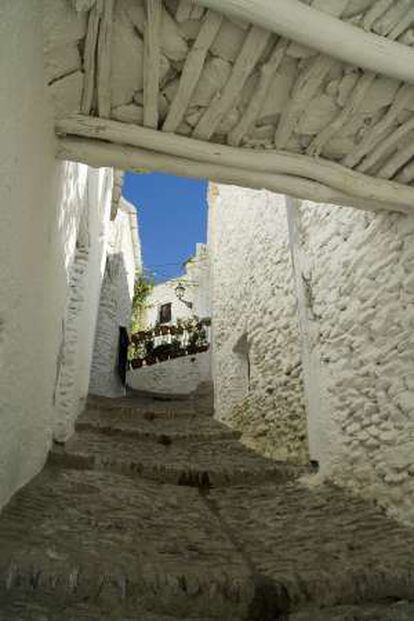Las Alpujarras is a region of mountain villages nestled among the Sierra Nevada range in Granada province, in the southern Spanish region of Andalusia. Three such villages, which belong to the Spanish Beautiful Villages Association, lie in the Poqueira gorge – Capileira, located 1,400 meters above sea level, Bubión (1,300 meters) and Pampaneira (1,058 meters). These traditional villages receive thousands of visitors each summer, but in autumn and spring, attract mostly mountain-lovers and hikers eager to explore the area, which sits at the foot of Mulhacén mountain. But climbing Mulhacén, which at 3,479 meters above sea level is the highest peak in the Spanish peninsula, is only one of the many activities visitors can enjoy in this picturesque valley.
Mountaineering for beginners
“The Poqueira valley is the perfect place to get started in medium- and high-mountain [climbing],” says Jesús Espinoso, founder of the company Nevadensis, which manages the information center at the Sierra Nevada National Park in Pampaneira, and has been guiding groups through the mountain range for 30 years. Pampaneira’s closeness to the Mediterranean Sea calms the weather conditions during a large part of the year. From the Poqueira refuge, which is 2,500 meters above sea level and open year-round, visitors can explore six routes – the circular route that passes by several lagoons, two routes which follow different tracks to the Alcazaba peak (3,364 meters above sea level); one that leads to Veleta peak (3,396 meters) and two others to Mulhacén, although there are more ways to reach the summit.

The visitor information service of the High Peaks of Sierra Nevada (SIAC) in Capileira runs a bus to El Cascajar near the Alto del Chorrillo peak (2,600 meters). From here, visitors can reach the Loma del Tanto trail and get to the top of Mulhacén in three and a half hours. Getting down takes another two hours. From September, the bus service is irregular and depends on the weather conditions – it is cut off completely when the first snow arrives.
Wandering under ‘tinaos’
The villages Capileira, Bubión and Pampaneira, with their whitewashed buildings, ancient washing rooms, Moorish fountains, and terraos (homes without slate roofs), invite visitors to wander through the delightful chaos of their narrow and labyrinthine streets. The villages are known for their tinaos, a structure that connects two homes on opposite sides of the street, as though it were a gateway.

In Pampaneira, the first village in the Poqueira gorge, visitors are recommended to pass through the tinaos of the Real, Princesa, Cristo, del Viso and Silencio street. Afterwards, travelers can enjoy cured pork and traditional food such as other pork derivatives, migas (pan fried bread with sausage), gachas (a soup made of flour, water, salt, olive oil, and garlic), and chestnut stew. The village also has lots of artisan stores, with jarapas (brightly colored fabrics made from scrap material), the star product.
In Bubión, the next village on the upward route, travelers can visit a traditional weaving workshop – one of the few that still exist in the area – as well as various museums.
Sweeping views
Capileira has three neighborhoods at the foot of the Veleta peak, a Moorish washing room and a Moorish fountain. But the most interesting thing about the village is its lookout points. Looking down, visitors can see the three villages clinging to the gorge; looking up, there are the soaring mountains of Sierra Nevada range, and straight ahead, there is the view the Lúgar and Contraviesa mountain ranges. On clear days, it’s possible to see the Mediterranean Sea and even the coast of Africa.
Espinosa particularly likes the views from the Tajos del Ángel lookout: “The sunsets are spectacular when the peaks are covered in snow, which become awash in red tones.”
Mushroom picking
The three villages are surrounded by farming terraces and traditional crops, reminders of an agricultural past that has been overtaken by tourism. As visitors leave the villages, they enter into the wilderness and the Mediterranean forest, which becomes awash with color in autumn. “It is a very vertical landscape,” says Espinosa. Sierra Trails-Dallas Love, in Bubión, offers tours of the areas on horseback, and the BTT Nevada Center organizes routes in mountain bikes. Visitors can also rent mountain bikes from Alpujarra Bike in Bubión.
The paths that wind down from the three villages to the Poquiera River, which is crossed by four bridges, also make for a picturesque excursion. The Capileira city council website has a list of routes in the area, and the rules regarding mushroom picking in the natural park: a person can go no further than five kilometers each day, must not use rakes or hoes, and should carry the mushroom in baskets that will allow the mushroom spores to disperse. Visitors may find a range of wild mushrooms in the park including the saffron milk cap and king oyster mushroom.
English version by Melissa Kitson.
